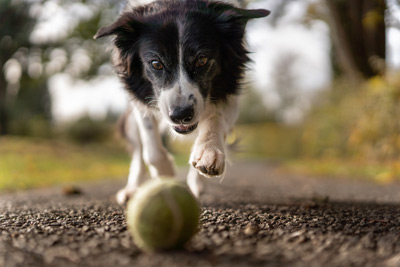
Dog Health & Wellness
When it comes to finding a forever home, unfortunately, behavioral issues are a common reason for dogs to be abandoned.
The good news is, many common behavioral concerns are manageable—with the right techniques for positive, kind, and effective training.
Here are two common behavioral challenges, and tips for managing them.
Under certain circumstances, otherwise-friendly dogs react in a way that’s totally out of their normal character, and even seems aggressive.
Two common scenarios are during leash walks, and when in possession of a valuable resource, such as food or a favorite toy.
Leash reactivity describes dogs who overreact to certain things—such as other dogs, people, or cars driving by—during their walks on leash.
A dog who’s leash reactive may:

Fear is one cause. The reactive behavior is designed to put distance between your pup and the trigger that scares them—for example, another dog.
Each time your pup successfully avoids the trigger by overreacting, their behavior is reinforced.
Frustration is another cause. It’s possible your pup wants to see the other dog, but due to the leash, they can’t perform their normal social interactions like circling and sniffing one another.
These dogs may be perfectly fine off-leash—but it’s important to know for sure before letting your dog loose in a leash-free environment.
In either case, lack of early socialization or a previous bad experience can also contribute to leash reactivity.
If your dog reacts poorly to a certain stimulus or trigger, the best treatment is to change their perception of the trigger—to help them see it as something positive.
To do this, you’ll need a high value treat, such chicken or hot dogs.
Cut the treat into small, pea-sized pieces (so it doesn’t interfere with your dog’s healthy diet) and bring the treats with you on walks.
During the walk, use the following steps:
It takes patience, but done correctly, this process will help your pup associate their trigger with something positive—treats!
It’s easier to start in a low-traffic area, and only go to more popular dog-walking spots when your pup is truly ready for it.

Resource guarding is your dog’s way of protecting something that’s very important to them, such as their favorite treat, a bone or chew, or their food bowl.
Food is the most common resource that dogs guard, but they may also guard toys, beds, and even people.
Guarding behaviors include:
This is normal, natural behavior for many dogs.
Fortunately, you can teach your dog a new way to behave and ensure that both you and your dog feel more comfortable.
Some pet parents choose to live with a pup’s behavior rather than modifying it, assuming the behavior is mild and not severe, and there are no children in the home.
For example, you could feed your dog in a room or crate, by themselves, where they feel safe.

1. Teach Sharing as Early as Possible
If your dog is young and you feel comfortable with their behavior around food, you can try feeding them kibble directly from your hand, and hand-holding larger treats as your pup licks and chews on them.
This helps your pup understand you have no intention of “stealing” their food.
2. The “Leave It” Command
Teaching your dog to “leave it” can help. However, “leave it” may not be enough on its own.
This command works best when combined with behavior modification, or when you allow your dog to “trade up”. This occurs when you offer them an even better treat as a reward for dropping what they already have.
3. Changing Your Dog’s Perception
Just like leash reactivity, you can teach your dog that their trigger (you approaching while they eat) is a good thing, not something to worry about.
Here’s how:
This example is for dogs who guard their food bowl but you can use the same process if your dog guards treats, toys, or other resources.
If your dog is happy and friendly most of the time and only reactive under very specific circumstances, you probably don’t have an aggressive pup.
Your dog wants to be happy and relaxed—it’s just hard for them if they feel nervous or uncomfortable in a given situation.
That being said, it’s still important to keep safety in mind. Even if your pup is otherwise a sweetheart, dogs who are stressed or scared may not behave like their normal self—and sometimes, this means biting is a possibility.
So, it never hurts to be cautious and use safety barriers (such as basket muzzles during walks, or tethering your pup’s leash to a secure post during resource guarding modification) for peace of mind—at least until your pup finishes their training.
A professional trainer or behaviorist can really help with safety and training efficiency, too.

Behavior modification takes time, but your patience will pay off. Slow and steady truly wins the race and results in lasting change.
It teaches your otherwise wonderful, friendly, loyal dog how to feel cool, relaxed, and confident in a situation that makes them nervous.
That way, you’ll both feel more comfortable, and there’s nothing in the way of the many happy days you’ll share together!
From our family to yours,
Fromm Family Pet Food